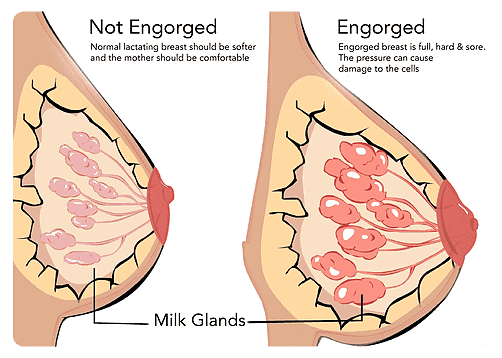Breast Engorgement: Symptoms, Causes & Treatment
What are the symptoms of breast engorgement?
Here are some common symptoms of breast engorgement:
- Breasts feel very full, hard, swollen, and painful
- Breasts may have a tight, heavy feeling
- Skin on breasts looks stretched and shiny
- Breasts feel warm to the touch
- The nipple area may be flattened and make breastfeeding difficult
- You may have a mild fever and body aches
Breast engorgement usually occurs when the breasts become overly full with milk, often in the first week after giving birth as the mother’s milk comes in. It can also happen if breastfeeding is delayed or if there is a missed feeding.
Other potential symptoms include:
- Breasts feel throbbing or burning
- Breasts may appear lumpy or red
- Plugged milk ducts can cause a small hard lump
- Engorgement can lead to a decreased milk supply if not remedied
Frequent breastfeeding or pumping to remove milk helps relieve the engorgement. Cold compresses and over-the-counter pain medication can also provide relief.
What are the causes of breast engorgement?
There are several potential causes of breast engorgement:
- Oversupply of milk
This is one of the most common causes, especially in the first few weeks after giving birth. The breasts become overly full as the milk supply increases and regulates itself. - Infrequent or missed feedings
If too much time elapses between breastfeedings or pumpings, the breasts can become engorged from the built-up milk. - Ineffective milk removal
If the baby is not properly latching and removing milk efficiently during feedings, it can lead to engorgement. - Supplementing with formula
Using formula in addition to breastfeeding can reduce breast stimulation and milk removal, resulting in engorgement. - Abrupt weaning
Stopping breastfeeding suddenly without gradually weaning can cause engorgement as the breasts are still producing milk. - Blocked milk ducts
A plugged duct that prevents proper milk drainage from part of the breast can create an engorged area. - Breast infections
Mastitis, an inflammation of breast tissue often due to infection, frequently causes breast engorgement. - Birth control pills
Certain birth control medications containing estrogen can increase breast fullness and engorgement.
Prompt treatment by frequently nursing/pumping and using comfort measures helps alleviate the discomfort of engorgement.
What is the treatment for breast engorgement?
Here are some of the recommended treatments for breast engorgement:
- Frequent breastfeeding or pumping
This is the most effective way to relieve engorgement by removing the built-up milk. Nurse the baby as often as possible, every 2-3 hours. If the baby has trouble latching due to the engorgement, express some milk first to soften the areola. - Cold therapy
Apply cold compresses or ice packs to the engorged breasts for 20 minutes at a time. This can help reduce swelling, inflammation and pain. - Warm compresses
Before breastfeeding, apply warm compresses to the breasts for 5-10 minutes. This can help the milk flow more easily. - Massage
Gently massage the breasts from the armpit down toward the nipple before and during feedings to help move the milk forward. - Cabbage leaves
Placing chilled green cabbage leaves inside the bra can provide anti-inflammatory relief. - Over-the-counter medications
Ibuprofen or acetaminophen can help relieve pain and inflammation from engorgement. - Correct latch
Make sure the baby is latching properly and removing milk efficiently during feedings. - Breast binding
As a last resort, binding the breasts can reduce milk supply, but this should only be temporary.
Getting prompt treatment by your healthcare provider is important, as severe engorgement can lead to plugged ducts, mastitis or a breast abscess if not remedied. Most engorgement resolves within a couple days with proper management.




